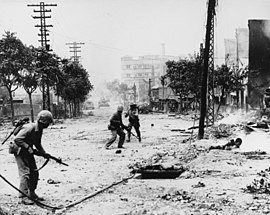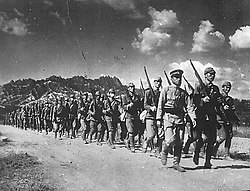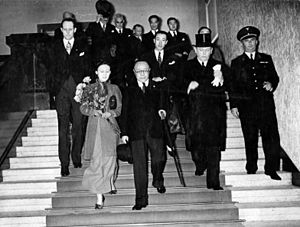War of the Confederation (Esquarium)
This article is incomplete because it is pending further input from participants, or it is a work-in-progress by one author. Please comment on this article's talk page to share your input, comments and questions. Note: To contribute to this article, you may need to seek help from the author(s) of this page. |
The War of the Confederation (Cortoguayan: Guerra de la Confederación, Oelian: Guerre d'la Confédération, Azawarecha : Iauatepen Uarhipeneri, other langs plox) was a military conflict in Nordania fought between the invasion of Salmántica in October 1940 to the signing of the Treaty of Rialto in May 1943. Spurred by a wave of military arms races and national irredentism, the war was fought between the Allied Powers, spearheaded by Oelia, and Ostrinubia; and the Confederation, a pseudo-fascist bloc made up of the authoritarian states of Cortoguay and Karazawa, and supported by like-minded states, including Luzarra.
Background
Fascist Agitation in Nordania
Salmántica was a Cortoguayan-speaking region formerly united with the rest of Cortoguay as part of the Intermarian League. However, Florencio Loyola de Santander was unable to unite the region with his newly-founded Republic of Cortoguay during the Cortoguayan Revolution, leaving it under Oelian control, divided between the provinces of Sålthal and Monserive â Såle. This situation was never accepted by the Cortoguayan political and military elite, and several failed overtures had previously been made to the government in Wéppy to return the region to Sevoyan control, to no avail.
Sócrates Solano rose to power in Cortoguay after mounting a coup against the embattled President Diego Zelaya Fiallos. Limiting the powers of the civilian government in favor of a quasi-military dictatorship, he was supported by a fascist movement that pushed for the repression of left-wing groups in the country as well as an aggressive, nationalist foreign policy. This largely grew out of a sense of dissatisfaction with the economic slump that had more or less persisted since the turn of the century, as well as revanchist sentiment from the humiliation of the Coffee War. Solano drastically built up the military, largely in response to the failed diplomacy over the Salmántica affair, which caused political tensions to escalate further. Historians also argue that Solano had developed the view that an Ostrinubian-Oelian alliance would put Cortoguay in a weakened strategic position, and that preemptive war would have to be fought against one or both of these powers within the next decade to prevent such an alliance from becoming too powerful. Nevertheless, talks continued between the two governments throughout 1939, with little success.
Foreign enterprises in Karazawa, particularly Cortoguayan businesses such as Cuyamel Conitia, led to the outbreak of a series of domestic conflicts in the late 1920s and early 1930s, collectively known as the Cuyamel War. The war led to the rise of General Kuruch Malnonfi in the Caconzicua, securing his position with the end of the civil war in 1936 and giving rise to the "Junta" Era. The Assembly and the Yrateq's cabinet were staffed with partisans and allies of the General, mostly officers of the army, creating a new military junta regime. Malnonfi renewed national modernisation programmes, through nationalized companies instead of foreign and private investors. Nevertheless, relations with Cortoguay remained strong, and even strengthened, as the two military rulers were alike in many aspects of their foreign and domestic policies.
Starting in 1915, Sozeragan Torasgoga, who assumed the position of Union Chief of Ostrinubia as a de facto dictator, began suppression of various factions and groups in Ostrinubian politics regarded as dissident. With the purge and execution of several high-ranking respected officials and generals, opposition to Torasgoga grew, and many Ostrinubian officials, union leaders and military officers fled the country. In Oelia and Cortoguay, expatriate Ostrinubians formed organizations opposing Torasgoga's dictatorship aiming to overthrow the Ostrinubian government. Eventually the movement called for restoration of the Eighth Ostrinubian Confederation to gain support and popularity from the syndicalism-suspicious governments of Nordania, becoming known as the restorationists, and became a major influence on anti-Ostrinubian policy of many Nordanian states.
Oelia, which had previously been the largest economic power in southern Nordania since the not!Treaty of Tordesillas, had been in a state of decline since the middle of the 19th century, with a faltering economic position that was exacerbated by the unification of Cortoguay and the independence of Karazawa. The global recession of the late 1930s further contributed to the support of populist and extremist parties, many of whose nationalistic platforms were perceived as hostility by the minority Cortoguayan and Karazawan populations. Especially those groups on the left thrived; in particular, Ostrinubian-inspired syndicalism became more far more prominent, worrying the staunchly right-wing Cortoguayan government.
Calls for increasing militarization were also strong; the increasing aggressiveness of Solano prompted the Oelian military to commence the construction of extensive border fortifications beginning in 1938; however, these would only be partially completed by the breakout of hostilities in 1940.
Confederation

In June of 1939, the representatives of the Republic of Cortoguay and the Caconzicua of Karazawa met in Novallas to discuss a potential alliance. Naval agreements and defense alliances had previously existed in various forms between the parties, but several in the military hierarchy called for a need for a more unified and coordinated entity in the event of a future war. The Novallas Conference and the ensuing treaty founded the South Nordanian Confederation, an organization intended to serve as an association and mutual defense pact of states throughout the continent. The pact was purportedly created to act as a move towards further Nordanian political and economic integration through acting as buffer against foreign intervention as well as internal subversion (syndicalist terrorism ostensibly supported by Ostrinubia), ostensibly through the channels of international arbitration.
Despite this, its true intention, outlined in a series of secret protocols, was to escalate the aggressive situation in Nordania at the time in order to provoke a diplomatic crisis or war which was expected to result in a toppling of the syndicalist government in Ostrinubia and/or significant land gains for the two state signatories; Oelia would be forced to cede Aomoe to Karazawa and Salmántica to Cortoguay. The syndicalists in Ostrinubia, long viewed as the primary destabilizing force in Nordania, were also condemned by the Novallas Treaty, with the Confederation instead recognizing a group of restorationists headed by popular former union leader Gazdar Bogsoi as the legitimate government of the country; though both signatories were hostile to syndicalism in general and Ostrinubia in particular, the inclusion of such strong rhetoric in the treaty was largely attributed to Solano's support of the cause.
Confederation offensive
Invasion of Salmántica (1940)
With the Malboda incident, Solano decided that the time was right to retake North Cortoguay, and unilaterally issued a declaration of war on Oelia. With the main objectives to secure the H'oge-Såle and Bage-Såle regions (with operational plans focusing on the strategically crucial city of Betange), the declaration was immediately followed by numerous infantry and armored units crossing the border through the heavily-forested regions of Farberstèd. Caught off guard, Oelian forces initially offered little resistance, with the sole major stand at Lixange plagued by poor communications and allowing a hole to be punched through the shattered lines and up the Såle valley. The swift progress of the Cortoguayan III and IV Divisions forced Oelia to hastily adopt scorched earth tactics.
Even in the wake of the Cortoguayan advance, however, resistance against the occupying forces continued. Although the majority of Salmántica was ethnically-Cortoguayan, a large minority (nearly 30%) was Oelian-speaking, and these communities fled into the hills and organized resistance groups from town militias and rifle clubs. By late 1940, the extensive coordinated network of partisans, labeled by the Cortoguayans as francotiradores, began to seriously hinder Cortoguayan supply lines. Despite the optimism expressed by Solano to the other Confederation leaders that "[his] front [would] be won by Christmas," the chaotic situation behind the front lines, necessitating the breaking off of several front line units for "pacifying actions", forced the offensive to stall just outside of Betange in early November. Both sides, realizing they could not continue the fight without bringing up substantial reserves, dug in for the winter, with Cortoguay occupying a substantial portion but not all of Salmántica; this would remain the case for the next two months.
Invasion of Aomoe (1940)
Records from the period show that Kuruch Malnonfi and the rest of the Karazawi Army were taken by surprise by the Cortoguayan offensive on Salmantica, as they had not yet completed preparations for the oncoming war. The Cortoguayan ambassador requested that Malnonfi speed up his mobilization plans and declare war, and the dictator reluctantly agreed.
3 days after the Cortoguayan invasion Karazawa officially joined the war on the side of the Confederation and troops entered Aomoe where they, at first, met little resistance. The land offensive was also coupled with maritime operations to block and oppose the Oelian fleet and to occupy Oelian ports; this too was largely successful, and the coastal raids hindered any Oelian naval support of the Oelian Army's defense of Aomoe.
However, the army was unable to capitalize on its early success, such as the occupation of Pulkap, and the offensive was quickly halted by the arrival of Oelian reserves. The front even moved back a few kilometers into the territories occupied by Karazawa, until it eventually stabilised in mid-November, both sides unable to make real progress beyond that point. Despite Karazawa's initial defeat of the Oelian fleet, their own navy was incapable of maintaining naval superiority, with a similar impasse in the air.
Rouëlange campaign (1941)

An ambitious Cortoguayan offensive in mid-January 1941, aimed at disrupting Oelian supply lines in northern Sålthal, was bloodily repelled, and failed to break the deadlock; this was largely blamed on the Army High Command's use of the same shock-and-awe tactics as in October, and the failure allowed Solano to take a more active role in strategic planning. In the following months, Oelian forces were slowly pushed out of most of Monserive before the Cortoguayan III Division attempted to strike towards the city Sålguemind, from which they could move out of the hills into the plains of Oelia proper; here they were again thwarted in their efforts. By spring, there were still no major population centers under Cortoguayan control.
Solano devised an ambitious operational plan to take the city of Rouëlange, an important railway and road junction, viewed by many as "the guardian of the Sålguemind highway". With the Oelians expecting the next offensive to be aimed at the Betange area, Solano reasoned he could quickly punch through the defensive lines through the use of overwhelming force, assembled with the bulk of the army as well as reserve units. Although military planners worried this would spread the rest of the lines too thin, the plan was given the go ahead.

Case Red began on April 29, 1941. Although they made quick initial progress, the Cortoguayans were forced to advance along a narrow front due to poor roads and destroyed bridges, nullifying their numerical advantage while allowing their forces to be picked off from the air; this Oelian aerial superiority helped allow forces to be scrambled to the defense of Rouëlange before the city was ultimately encircled on May 10. There was a pause for resupply before Cortoguayan troops moved into the city on May 13; forward formations were repelled with high casualties. Enraged, Solano ordered the city levelled; for a week, nonstop artillery and bombing raids decimated the city into ruins. However, despite the property devastation, the Oelian defenders largely survived the bombardment, and when forces reentered the ruins of the city on May 20, they faced stiff resistance that quickly escalated into street fighting and hand-to-hand combat. The bitter fighting continued for weeks as Solano insisted on funneling more troops into the city; however by early July they only controlled half the city; Oelia had become determined not to surrender the city, and it's defense took on a near mythical propaganda status.
The battle took on a similar importance for Cortoguayan morale, with propaganda urging citizens to enlist and buy war bonds to support the soldiers in Rouëlange. Despite this, however, military planners failed to pick up on the significant buildup of Oelian forces behind the River Bolleuÿ, in preparation for a massive counterattack. In the late hours of July 11th, the Oelian reserves initiated a huge encircling movement to the east and west of the city, driving south and avoiding the main Cortoguayan flanks. Due to poor communication, the Cortoguayan 3rd Army was caught off guard and would be completely encircled by July 15th. Solano gave the army commander General Agustín Blanco Muñoz strict orders to not attempt a retreat, promising resupply by air; however, this ws not feasible given Oelian air superiority. The units trapped in the pocket were undermanned and rendered completely immobile, and Blanco was forced to dig into defensive positions. A Cortoguayan relief attack, in an attempt to break the siege ring, had to be canceled on August 5th, due to the invasion of Ostrinubia.
Invasion of Ostrinubia (1941)
[...]
The Cortoguayan offensive was greatly aided by the persisting influence of supporters of restorationist leader Gazdar Bogsoi, many of which reached commanding positions in the military after Torasgoga's death in 1935 and the relative leniency of Nuiche Zaratz with regards to these elements (although, Zaratz continuing to uphold Torasgoga's authoritarian and fervently revolutionary legacy caused these restorationists and sympathizers to remain opposed to the government). When the offensive temporarily stalled due to toughening resistance, numerous divisions of the PAFUCO defected and proclaimed themselves loyal to the Committee for Restoration of Legitimate Articles, occupying many key positions and cities and allowing Cortoguayans access through southern Ostrinubia. This came as a great shock to Ostrinubian forces, but they were able to regroup and suppress the uprisings of collaborationists positioned behind the frontline, although the distraction of forces from the frontline for this helped further Cortoguayan gains. By late 1941, Confederation forces had occupied up to the Zagide river.
In Goratzage, a city in southern occupied Ostrinubia, the Committee organized a government nominally administering the 'liberated' territories on DATE. Bogsoi was inaugurated as the restored Eighth Confederation's first Chief, while other expatriate officials and officers made up much of the government. The defected Ostrinubian troops were joined by some 2,000 expatriate volunteers to form the 140,000-strong Ostrinubian Liberation Army, representing a massive part of the Ostrinubian military prior to the war.
These developments however did not significantly shake the morale of loyalist Ostrinubian troops, in part due to state media quickly exploiting the news to create the image of a critical attack on the Ostrinubian nation assisted by the 'worst of reactionary traitors'. Zaratz's political standing was consolidated, as he used the opportunity to purge several major military officers in disagreement with him and the new assembly of commanders were able to quickly control the situation, establishing a solid line on the Dasatzek River. The defection of dozens of divisions was made up for by mass conscription in the rear, raising quickly nearly 1 million by the start of 1942.
The defector troops fought fanatically and were very combat-effective due to their professional nature, largely freeing up Cortoguayan forces from further involvement in Ostrinubia until 1942. About 90,000 Ostrinubian troops were encircled and captured after a renewed winter offensive, many of which joined the ranks of the collaborators. Partisan resistance began in occupied areas however at this point, reducing the ability for Confederation forces to strike deeper.
[...]
Allied counteroffensive
Battle of the Lazarene Sea (1942)
In a bid to secure the security of their northern campaigns, Cortoguay needed to assume control trade in Conitia and the South Central Ocean; to this end, the newly-modernized Cortoguayan navy declared unrestricted commerce raiding on ships perceived to be trading with the X, a move decried by the international community. 1941 saw increasing harassment of Aininian shipping in the Lazarene Sea by Cortoguayan vessels. After several sinkings and international outrages, President frenchie mcfrenchieface requested a declaration of war, which would be passed on January 17th, 1942
Naval action in early 1942 consisted of raids and pursuit by the larger vessels of the respective navies. After an ill-fated foray into the open South Central, the Cortoguayan surface fleet removed closer to the mouth of the Lazarene Sea as the long distance supply became a problem. Several moves were made by Aininian Admiralty to combat the threat, using for the first time both land and carrier based aircraft, in a brief campaign that would culminate in the August sinking of the Cortoguayan flagship Rojas Pinilla, allowing Cedarbrookese naval forces to enjoy relative freedom of movement into the Lazarene Sea.
In early January 1943, after the inability of the Aininian fleet to decisively defeat the Cortoguayan Navy following this sinking, naval action in the Lazarene took a brief pause. Fearing a military buildup, it stepped up the policy of unrestricted submarine warfare and expanded it to all vessels in the Lazarene Sea. Among the ships torpedoed was the Pavonistadian naval corvette Achcautlii, killing 120 Pavon sailors in what became known as the Achcautlii incident. While a formal apology was delivered to the Pavonistadian government, Solano refused to pay any reparations and, in a series of speeches, vitriolically attacked the Pavons, leading the country to join the war with the Allies.
With this bolstered assistance, Aininian surface vessels massed in the Lazarene and chased most of the Cortoguayan fleet into port at Fuerteventura. With both aircraft carriers within 200 nautical miles of the port, waves of dive bombers protected by fighters attacked the Cortoguayan fleet on October 28 and 29, 1943. The Cortoguayan Navy never recovered from the destruction. 20% of vessels harbored were sunk, with the toll rising to 50% of cruisers and battleships. For the most part, he crippled Cortoguayan Navy ceased surface operations after the raid, allowing the Allies to plan for an invasion of Cortoguay.
Invasion of Cortoguay






